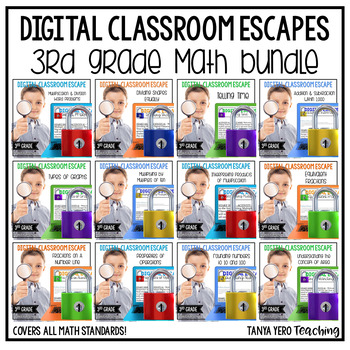3rd Grade Math Digital Escape Room YEALONG BUNDLE | ALL STANDARDS
- Zip
- Google Apps™

What educators are saying
Products in this Bundle (24)
showing 1-5 of 24 products
Description
Looking for a fun way to practice a math skill, implement spiral review, or integrate test prep? Math Digital Classroom Escapes are just what you and your students need! This bundle includes a digital breakout challenge for each 3rd grade math standard at a discounted price! Each escape room has an animal theme; perfect for your 3rd graders!
***CLICK HERE to view a FREE sampler of a 3rd grade digital escape!***
A Digital Classroom Escape is an interactive activity which promotes peer collaboration and problem solving. Cryptic messages, challenges, and puzzlers combine to create the perfect blend of learning and fun!
This Tanya Yero Teaching resource can be used in the classroom and/or for distance learning/ remote learning.
What is a Digital Classroom Escape? A digital classroom escape is an interactive activity in which teams of students use clues to solve challenges and unlock “digital locks.” These activity consists of 3 challenges and puzzlers that students must complete.
What do I need to access these escapes? You need access to the internet and technology devices. These escapes work on Chromebooks, iPads, and laptops! You DO NOT need a Google account or access to Google Classroom to use Digital Classroom Escapes.
What do I get with this resource? You will get the link to access your Digital Classroom Escape along with DETAILED teacher directions and tips for every step of the activity. Answer keys and suggestive clues are also provided.
Benefits of a Digital Classroom Escape
➥ Aligned to math curriculum
➥ EASY PREP! Nothing to print except for teacher directions and tips.
➥ Interactive for students
➥ Immediate student feedback
➥ Promotes team building/ peer collaboration
➥ Promotes problem solving skills
➥ Targets technology standards
Standards & Topics Covered:
Number and Operation in Base Ten
➥ 3.NB.1 - Place value concepts
➥ 3.NBT.2 - Adding & subtracting whole numbers
➥ 3.NBT.3 – Multiplying numbers
Operations & Algebraic Thinking
➥ 3.OA.1 - Interpreting products of whole numbers
➥ 3.OA.2 – Interpreting quotients of whole numbers
➥ 3.OA.3 – Use multiplication and division to solve word problems
➥ 3.OA.4 – Determining unknown numbers in a multiplication or division equation
➥ 3.OA.5 – Apply properties of operations to multiply and divide
➥ 3.OA.6 – Understand division as an unknown-factor problem.
➥ 3.OA.7 – Fluently multiply and divide within 100
➥ 3.OA.8 – Solve two-step word problems using the four operations.
➥ 3.OA.9 – Understanding patterns on a multiplication chart
Number and Operation - Fractions
➥ 3.NF.1 – Understanding fractions
➥ 3.NF.2 – Understanding fractions on number lines
➥ 3.NF.3 – Equivalent fractions and comparting fractions
Measurement and Data
➥ 3.MD.1 – Understanding time
➥ 3.MD.2 – measuring and understanding liquid volume and mass
➥ 3.MD.3 – Picture graphs
➥ 3.MD.4 – Measuring length and using line plots
➥ 3.MD.5 – Understanding area
➥ 3.MD.6 - Measuring area
➥ 3.MD.7 - Relate area to the operations of multiplication and addition.
➥ 3.MD.8 – Word problems with area and perimeter
Geometry
➥ 3.G.1 – Understanding and examining shapes
➥ 3.G.2 - Partition shapes into parts with equal areas.
>>>>>>>>>>>>>>>>>>>>>> PLEASE READ BELOW <<<<<<<<<<<<<<<<<<<<<<
****Want to test out one of our escapes for FREE? CLICK BELOW!****
FREE MATH DIGITAL CLASSROOM ESCAPE
!!! TEST TO SEE IF YOUR DISTRICT BLOCKS THIS SITE FIRST! TRY OUR FREEBIE ESCAPE TO ENSURE THAT THE LINK WILL WORK ON YOUR STUDENTS' TECH DEVICES. I AM NOT RESPONSIBLE IF YOUR DISTRICT BLOCKS THE WEBSITE. IF YOU GET A 404 ERROR THAT MEANS YOUR DISTRICT HAS IT BLOCKED. YOU CAN EMAIL YOUR DISTRICT WITH THE LINK ASKING FOR PERMISSION. IN MOST CASES I HAVE WORKED WITH THE DISTRIST DOES GRANT PERMISSION. !!!





